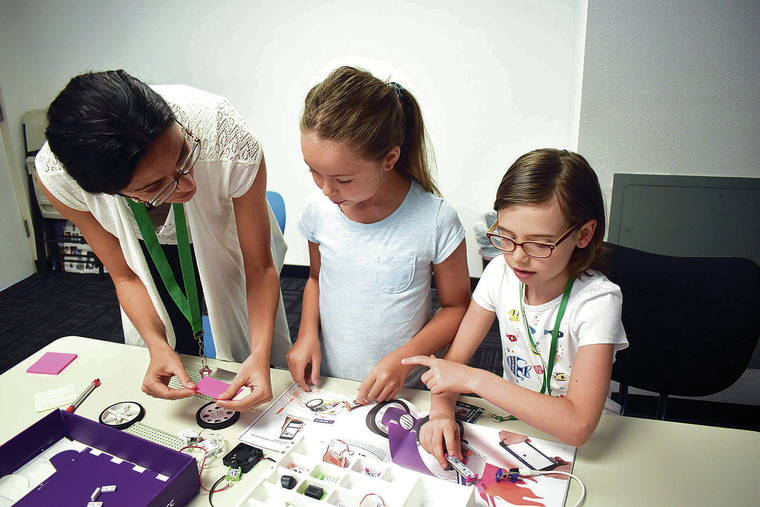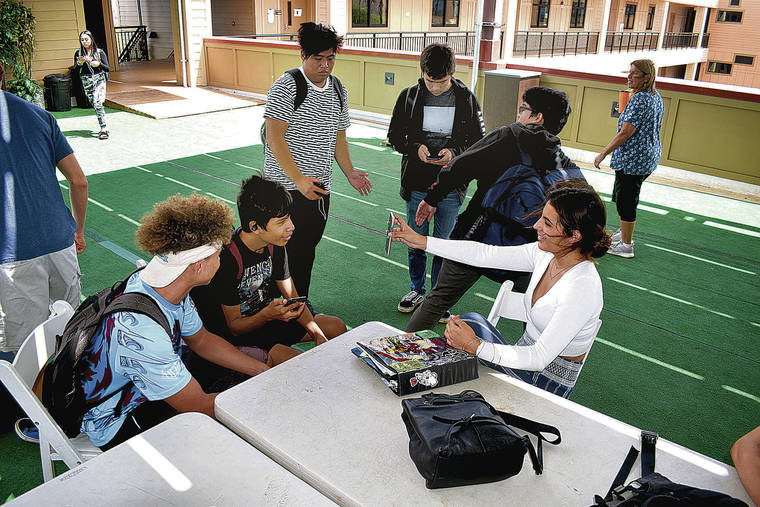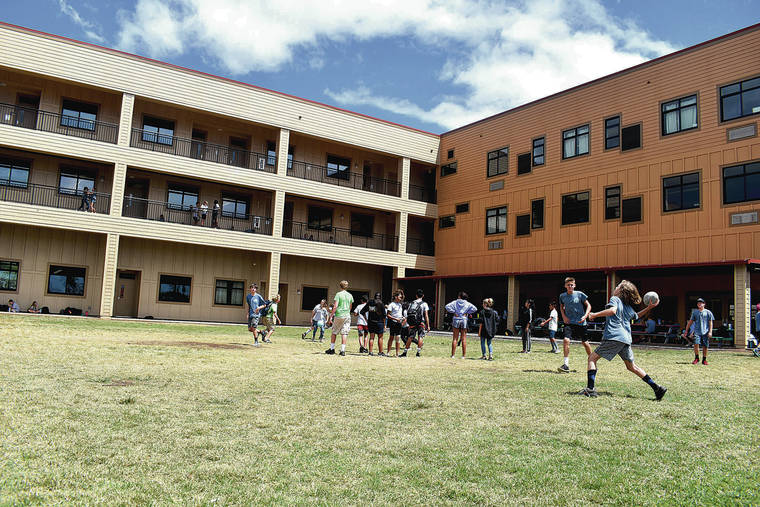KIHEI, Maui >> Less than a year after opening its custom-built hilltop facility, Kihei Charter School has become one of the state’s largest charter schools — even after turning away more than 150 children in August for lack of space.
Meanwhile, Hawaii Technology Academy’s enrollment has nearly doubled in the last three years at its learning center on the second floor of a commercial building on Main Street in Wailuku.
Charter schools make up just a small chunk of the educational landscape, especially on Maui, but they are growing faster than other public schools in Hawaii. Most of the state’s 37 charters are on Oahu and Hawaii island, with five on Kauai and one on Molokai. Maui has only two charter facilities.
Statewide, 11,877 students attend charter schools, up 2.8% over last fall. They account for 6.6% of overall public school enrollment, which dipped by a barely perceptible 0.2% to 179,331 this year.
“I know that families are coming to us because they are looking for that one-on-one interaction, the additional support for students that they don’t necessarily get elsewhere,” said Kristie Fetterly, campus director for Hawaii Technology Academy on Maui.
Charters are tuition-free public schools that aim to offer alternative approaches to education and are run by independent governing boards, rather than the Department of Education. They operate under performance contracts, or “charters,” with the Hawaii Charter School Commission, and are funded largely by tax dollars.
Hawaii Technology Academy, the state’s largest charter school, offers “blended learning,” a mix of online classes taken at home and face-to-face instruction. It serves 1,285 students statewide. The academy’s Maui enrollment surged to 189 students this year, up from 99 three years ago.
Kihei Charter School’s student body of 689 on the state’s official count date represents a 31% rise over three years and makes it Hawaii’s fifth-largest charter school. Enrollment has since ticked up to 701 students, and an additional 151 students remain on its wait list, mostly for kindergarten through third grade.
“I think the school is thriving because it’s personal,” said Ellen Federoff, dean of students. “Every teacher knows every student’s name. We have the opportunity to get to know our students better because we’re kindergarten through 12th grade. They become ohana.
“This facility helped, too,” she added with a grin, standing on the school’s rooftop deck where seniors were taking a break with a sweeping coastline view, shaded by solar panels.
Project-based learning
After years of making do with cramped quarters in a strip mall, an industrial park and a church, Kihei Charter opened its new $20 million home at the top of Lipoa Parkway on Oct. 22. The three-story, steel-and-concrete building was financed with an $18.8 million loan from the U.S. Department of Agriculture’s Rural Development program.
Jared Pardo, a junior from North Kihei, believes going to Kihei Charter shifted his life course. He asked his parents whether he could switch to the charter in seventh grade from his intermediate school, where he was struggling for various reasons.
“Most of my friends are taking college classes now, and they’re juniors,” he said. “That kind of work ethic rubs off on you, and I’m sure it rubs off on other people. I think that Kihei Charter has such a positive environment that it allows them to sort of blossom.
“If it wasn’t for Kihei Charter,” he added, “I definitely would have considered dropping out and pursuing my GED. This school has given me a lot of opportunities. I think about that every day. I’m grateful for that.”
Kihei’s academic approach has evolved since it was founded in 2001 as one of the state’s first charter schools. Project-based learning remains a hallmark, and the school’s vans shuttle students to various sites for science exploration or community service. But after years of offering just part-time school with online work at home, it now gives face-to-face instruction for a full school day.
Academic proficiency rates at Kihei Charter exceeded the statewide averages in language arts and science but fell short in math, according to the 2019 Strive HI report. Hawaii Technology Academy also outpaced the state in language arts and science, tying the state’s math proficiency rate. But such comparisons are problematic, since the charters serve different student populations.
HTA and Kihei, for example, have virtually no English-language learners and just half the proportion of economically disadvantaged students as Hawaii public schools, which is almost 50%. The percentage of students needing special education is more comparable: 10% statewide for public schools, 8% for HTA and 7% for Kihei Charter, according to the 2019 Strive HI report.
Parental commitment
HTA attracts many families who are used to home schooling, because its students spend at least half of their weekdays working from home. Elementary students must have a learning coach, typically a parent, to guide them through their studies at home.
Tagi Gorg brings her 6-year-old son to HTA’s learning center in Wailuku once a week, which she considers important for his socialization, and she appreciates the direction the academy provides her as a learning coach.
“I like the curriculum,” she said, pausing in the parking lot after picking him up. “It incorporates nature and outside time. A lot of the assignments say, go outside, do this, pick this up, examine this.”
Sky Ramey, a 10th grader, commutes to HTA’s Wailuku facility from Hana with her older sister, which means her mother drives two hours each way for the two days a week the girls report in person to school.
“We were kind of unsure about it in the beginning, but my mom said she was willing to do anything for education,” Ramey said. “It’s worth it because this school is really helpful. They are really hands-on.”
The school’s approach to learning is so different that parents and students are required to attend an information session before they apply for admission.
In an expository writing class last year, seniors came up with the idea of creating a “MindfulNEST,” a cozy spot for kids to decompress when they are feeling stressed. They wrote a grant application and received funding from Teaching Tolerance. The nest has lounge pillows, “fidget” toys to release energy and a biofeedback station where students can track and reset their emotions. The grant includes faculty training.
Teachers say they relish the freedom they have with their classes and students in the charter format.
“I love that it is personalized so that we can really tailor our lessons to each individual student,” said social studies teacher Kim Hockett. “You can really get to know that student and what their needs are, and that’s what education should be.”
Different approaches
A third charter school, Myron B. Thompson Academy, offers education remotely to neighbor island students and has 13 Maui students enrolled this academic year, according to its registrar. But it does not have a location on the Valley Isle.
Without facilities funding from the state, charters often lack the trappings of a traditional school, such as career academies, marching band or symphony, major drama productions or lots of clubs and sports.
Kihei Charter offers several sports, and its boys tennis team was crowned Maui Interscholastic League champion in April. The school’s top boys singles player, Hobbes Wilstead, went on to place second at the state championships while Kihei’s Jessalyn Lopez claimed the girls singles title.
Charter school students also may play on sports teams at their neighborhood public schools.
“There is no one educational model that’s perfect for everyone,” said Gene Zarro, CEO of South Maui Learning Ohana, which founded Kihei Charter School and is its landlord. “But for students who would benefit from Kihei Charter School’s approach, we are really good at what we do.”
—
Hawaii’s largest charter schools:
School name/location/number of students
>> Hawaii Technology Academy, statewide, 1,285 students
>> Kamaile Academy, Waianae, 878 students
>> Hawaii Academy of Arts and Science, Pahoa, Hawaii island, 710
>> Ka Waihona o ka Na‘auao, Waianae, 694
>> Kihei Charter School, Kihei, Maui, 689






